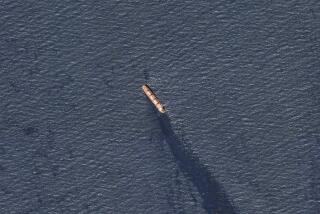What’s behind Iran’s actions in the Strait of Hormuz?
The seizure of a British oil tanker in the Strait of Hormuz by Iran’s Islamic Revolutionary Guard Corps is the latest example of how tensions between the U.S. and Iran have spilled into one of the world’s most strategic and vital waterways for oil. Since May, Iran has been accused of harassing and attacking oil tankers in the strait.
As the British government continues to investigate Friday’s seizure, experts worry that it raises the potential of a military clash. However, they also say it offers a lens into Iran’s strategy toward the U.S.
Here is a look at what’s been happening and why the Strait of Hormuz matters.
Why is the Strait of Hormuz important?
The Strait of Hormuz is the busiest, most important waterway for the world’s oil industry. More than a third of the world’s seaborne oil passes through the strait, which connects the Persian Gulf and the Gulf of Oman and is situated between Oman and Iran. In 2016, the Energy Information Administration estimated that 18.5 million barrels of oil passed each day through the shipping lane, which is only two miles wide.
What’s been going on there?
Over the last several months, the United States has accused Iran of attacking and harassing commercial shipping vessels on the waterway, as well as shooting down a U.S. drone over the Persian Gulf.
And American warships have had close encounters with Iran’s Revolutionary Guard.
In recent weeks, the U.S. and its allies have found themselves responding in a tit-for-tat with Iran. On July 4, British marines seized an Iranian oil tanker off the coast of Gibraltar after claiming it had violated European Union sanctions by transporting oil to Syria. Late this week, the U.S. said it had downed an Iranian drone; Iran denied it.
The events have raised concerns that the tensions could lead to a military conflict.
This isn’t the first time that the Strait of Hormuz has been the site of international conflict. During the Iran-Iraq war in the 1980s, the waterway became a point of contention for the warring countries. Iran placed sea mines in the paths of ships, and Iraq retaliated by firing missiles at them.
What is Iran trying to achieve?
Experts said Iranian officials are trying to demonstrate to the U.S. and its allies that the Islamic Republic is able to push back and gain leverage against the Trump administration’s “maximum pressure” policy, which intensified after President Trump pulled the U.S. out of the landmark nuclear deal in May 2018 and reimposed crippling sanctions, making it difficult for Iran to export oil, the foundation of the country’s economy.
China, Russia and leading Western European countries have sought ways around the U.S. sanctions, but it has been difficult to bypass them.
“The message that Iran is sending is that it is capable of making international waters unsafe not just for the U.S., but for international trade,” said Reza H. Akbari, a program manager and Iran expert at the Institute for War and Peace Reporting.
By escalating the risk of conflict in the Strait of Hormuz, Ariane Tabatabai, an associate political scientist at Rand Corp., said that Iranian officials will be able to use that as leverage and as bargaining chips if they were to resume negotiations with the U.S.
“The Iranian strategy is designed to get Europeans and the international community to step up and force the U.S. to change its policy,” Tabatabai said.
“Iranian officials want to make sure the international community also understands that they have a stake. But the situation remains fragile, and it’s unclear whether Iran’s gamble will pay off or raise the risk of a military conflict.”
Even though it’s still too early to declare whether Iran’s strategy will work in its favor, hard-line officials have managed to sell its importance to Iranians, according to Akbari.
“Iranian Revolutionary Guard Corps are showing that it can protect Iran’s land and maritime borders,” he said.
Still, Iran’s strategy runs the risk of backfiring, according to Tabatabai. That’s because if tensions continue to build in the Strait of Hormuz, Iran runs the risk of pushing the international community toward the side of the U.S.
“The more Iran brings the British into it, the closer it drives them toward the U.S.,” she said.
More to Read
Start your day right
Sign up for Essential California for news, features and recommendations from the L.A. Times and beyond in your inbox six days a week.
You may occasionally receive promotional content from the Los Angeles Times.






